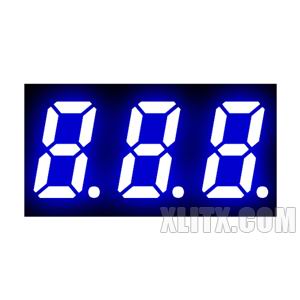LED temperature and light flux (V) relationship curve, from the following figure shows that the light flux and temperature are inversely proportional, 85℃ when the light flux is half of 25℃, and a 40℃ time output is 25℃ 1.8 times. The change of temperature also has a certain effect on the wavelength of LED.
Blue 7 Segment Display LED
7-Segment 0.56" 2-Digit Dual Common Anode CA
Orange Seven Segment LED Display
0.5 inch 0.5" Three Digit 3 Common Anode 0.50inch
White 7seg Display Seven Segment
LED 0.52 inch 0.52" 2 Digit Dual CA CC
Red Ultra Bright LED 7
Segment Display 0.36 inch Dual Digit Common Anode CA
Yellow LED Seven Segment Display
0.36" Four Digit 4 Common Cathode CC
White 7seg Display Seven Segment
LED 0.25 inch 0.25" 4 Digit Four CA CC
Yellow Green LED 7 Segment
0.3 inch 0.3 2 Digit Dual Display Common Cathode CC
Yellow Green LED 7 Segment
0.56 inch 3 Digit Three Display Common Cathode CC
Green 7 Segment LED Display
0.39 inch Single Digit 1 CC CA
Green 7 Segment LED Display
0.52 inch Single Digit 1 7-seg CC CA
Luminous Angle is small, the intensity of light is up, but the irradiation range will be reduced. Therefore, another important indicator to evaluate the LED lamp strip is the light Angle. There are some bad manufacturers on the market, in order to improve the brightness of the light to earn higher profits, deliberately reduce the Angle of light, a little careless, will buy such shoddy components.
3231AB 7-segment
3231AB LED
3231BB Display
3231BB
SMD uses surface mount technology (SMT), which has a relatively high degree of automation, and has the advantages of small size, large scattering Angle, good luminous uniformity and high reliability. Effectively solve the high density package-COB process, COB is Chip on Board packaging technology. Different from SMD welding lamp beads and PCB, COB process first covers the placement point of the silicon wafer with thermal epoxy resin (epoxy resin doped with silver particles) on the surface of the substrate, and then sticks the LED chip to the interconnected substrate with conductive or non-conductive adhesive through adhesive or solder.
5021AS LED
5021AS 0.50 inch
5021BS 7-Segment
5021BS Display
The relationship between LED light flux and temperature is a critical factor in optimizing performance and ensuring longevity, as elevated temperatures significantly reduce luminous output and alter wavelength characteristics. To counteract the inverse proportionality between light flux and temperature—where flux at 85°C drops to half of that at 25°C—advanced thermal management strategies are essential in LED driver design. Implementing temperature compensation circuits within the power supply can dynamically adjust current to stabilize light output, mitigating the impact of thermal variations. This is particularly vital for high-density applications, such as COB (Chip on Board) packaged LEDs used in compact, high-output lighting systems, where heat concentration is a persistent challenge.
Red
12011AS LED
12011AS 1.20 inch
12011BS 7-segment
12011BS Display






